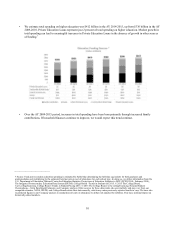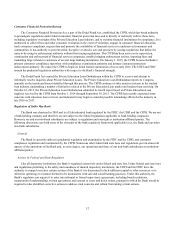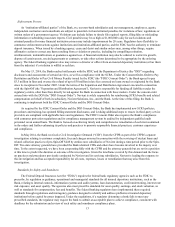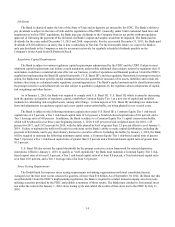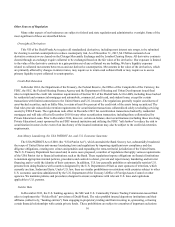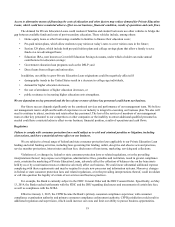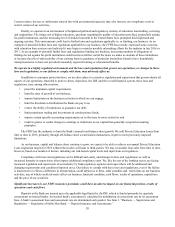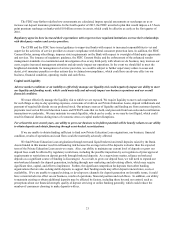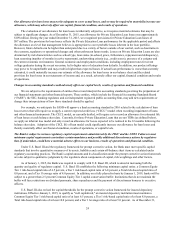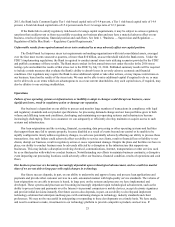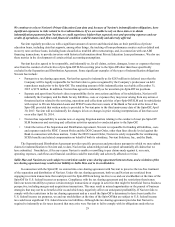Sallie Mae 2015 Annual Report Download - page 22
Download and view the complete annual report
Please find page 22 of the 2015 Sallie Mae annual report below. You can navigate through the pages in the report by either clicking on the pages listed below, or by using the keyword search tool below to find specific information within the annual report.20
Consent orders, decrees or settlements entered into with governmental agencies may also increase our compliance costs or
restrict certain of our activities.
Finally, we operate in an environment of heightened political and regulatory scrutiny of education loan lending, servicing
and originations. The rising cost of higher education, questions regarding the quality of education provided, particularly among
for-profit institutions, and the increasing level of student loan debt in the United States have prompted this heightened and
ongoing scrutiny. This environment could lead to further laws and regulations applicable to, or limiting, our business. As an
example of potential further laws and regulations applicable to our business, the CFPB has recently expressed some concerns
with education loan servicers and indicated it may begin to consider possible rulemaking efforts for the industry in late 2016 or
2017. As an example of potential further laws and regulations limiting our business, increasing numbers of allegations or
findings levied against for-profit institutions could lead us to further curtail the loans we make to students of these institutions
or increase the risk of enforceability of our existing loans to graduates of particular institutions found to have fraudulently
misrepresented or to have not provided reasonably expected training or educational benefits.
We operate in a highly regulated environment and the laws and regulations that govern our operations, or changes in these
laws and regulations, or our failure to comply with them, may adversely affect us.
In addition to consumer protection laws, we are also subject to extensive regulation and supervision that govern almost all
aspects of our operations. Intended to protect clients, depositors, the DIF, and the overall financial system, these laws and
regulations, may, among other matters,
• prescribe minimum capital requirements,
• limit the rates of growth of our business,
• impose limitations on the business activities in which we can engage,
• limit the dividend or distributions the Bank can pay to us,
• restrict the ability of institutions to guarantee our debt,
• limit proprietary trading and investments in certain private funds,
• impose certain specific accounting requirements on us that may be more restrictive and
• result in greater or earlier charges to earnings or reductions in our capital than generally accepted accounting
principles.
The FDIC has the authority to limit the Bank’s annual total balance sheet growth. We sold Private Education Loans from
time to time in 2015, primarily through off-balance sheet securitization transactions, in part to meet previously imposed
limitations.
As our business, capital and balance sheet continue to grow, we expect to be able to achieve our annual Private Education
Loan origination targets for 2016 without the need to sell loans to third-parties. We may reconsider loan sales from time to time,
however, based on a number of factors, including our risk-based capital levels and input from our regulators.
Compliance with laws and regulations can be difficult and costly, and changes to laws and regulations, as well as
increased intensity in supervision, often impose additional compliance costs. We, like the rest of the banking sector, are facing
increased regulation and supervision of our industry by bank regulatory agencies and expect there will be additional and
changing requirements and conditions imposed on us. Our failure to comply with these laws and regulations, even if the failure
is inadvertent or reflects a difference in interpretation, could subject us to fines, other penalties and restrictions on our business
activities, any of which could adversely affect our business, financial condition, cash flows, results of operations, capital base
and the price of our securities.
Significant increases in our FDIC insurance premiums could have an adverse impact on our financial position, results of
operations and cash flows.
Deposits at the Bank are insured up to the applicable legal limits by the DIF, which is funded primarily by quarterly
assessments on insured banks. An insured bank’s assessment is calculated by multiplying its assessment rate by its assessment
base. A bank’s assessment base and assessment rate are determined each quarter. See Item 1. “Business — Supervision and
Regulation — Regulation of Sallie Mae Bank — Deposit Insurance and Assessments.”


